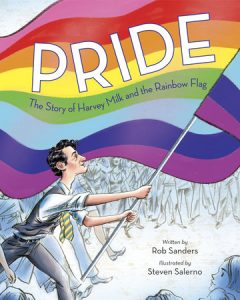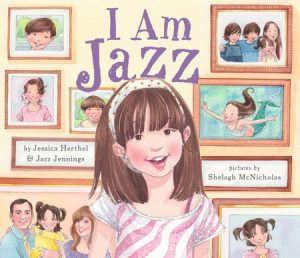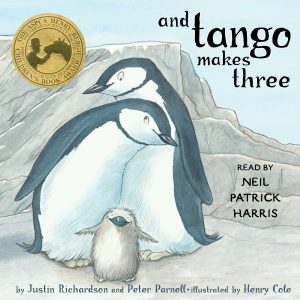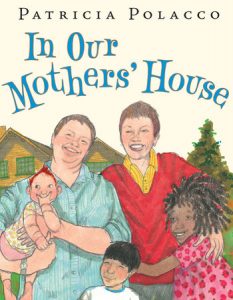By Deanna Day, Washington State University, WA, and Barbara A. Ward, University of New Orleans, LA
 In this WOW column, we will continue to explore the complex issues surrounding book challenges by focusing on the differences between book selection and book censorship or banning. It’s helpful first to define some terms and provide some historical context before revisiting the responsibilities of educators and sharing four picture books that have been challenged by parents in the past.
In this WOW column, we will continue to explore the complex issues surrounding book challenges by focusing on the differences between book selection and book censorship or banning. It’s helpful first to define some terms and provide some historical context before revisiting the responsibilities of educators and sharing four picture books that have been challenged by parents in the past.
The word “censorship” derives from the Latin word censere meaning to value or judge. Censorship is not a modern phenomenon, having occurred throughout history, often as a tool of those in power. In 213 B.C., the Chinese emperor Shih Huang Ti insisted that all of the books in his kingdom be burned, keeping only one copy of each for the Royal Library. Later, before he died, he insured that all of the books were destroyed because he wanted history to begin with him. In ancient Rome Emperor Caligula opposed the reading of The Odyssey by Homer because it expressed Greek ideas of freedom, something he didn’t want his citizens to consider. Thousands of copies of the New Testament Bible were publicly burned in 1526 on the order of London’s Roman Catholic Bishop. From 1929 to 1962 novels by Ernest Hemingway have been removed from school libraries in many states. Maurice Sendak’s picturebook In the Night Kitchen (1970) was removed from libraries because of an illustration of a nude boy. One of the most popular children’s series that has had multiple complaints and challenges is J.K. Rowling’s Harry Potter, because of the depictions of magic and witchcraft.
Each of us is probably uncomfortable with some issues, topics or content covered in books. For example, some colleagues have proposed deleting scenes or passages from classics such as The Adventures of Huckleberry Finn by Mark Twain because of the racist language and Dr. Suess’s books because some of them contain propaganda, caricatures and stereotypes. Even Laura Ingalls Wilder’s Little House on the Prairie series contains racist passages, prompting some individuals to suggest that those offensive scenes be cut and new versions of the books published and/or the authors and their work be discredited. In the case of Wilder, the American Library Association even changed the name of one of its awards—the Wilder Medal—to the Children’s Literature Legacy Award in 2018. Should these titles be completely banned or censored and revised? Aiello advocates that historical books are important pieces of social commentary on American culture. He explains that the books or the language used in them may make us uncomfortable but suggests that the books provide teachable moments to talk about where racial slurs come from and what they mean. Pamela Smith Hill told Fields (2021) that books are part of our history and we shouldn’t hide what has happened in the past with students. Instead, we need to honestly talk about these books so that children can reflect on the past. Books should be taught with their historical context, not through a revisionist or modern context. We want books to invite readers to critically read literature and to foster a more equitable, inclusive, critically thinking society.
 Currently, teachers and librarians are losing their jobs because they read aloud books, assign articles, and/or display books in their libraries. And the books and lessons that are being called into question might surprise most of us. For example, Matt Hawn had his high school students read an article about white racial resentment and view a poetry performance on white privilege. One month after these lessons he was fired. Assistant principal, Toby Price read aloud the picturebook I Need a New Butt! (McMillan, 2021) to second graders and was let go two days later. Recently a Georgia fifth grade teacher, Katie Rinderle was dismissed for reading aloud the picturebook My Shadow is Purple (Stuart, 2022) that challenges gender stereotypes and empowers kids to embrace their true selves.
Currently, teachers and librarians are losing their jobs because they read aloud books, assign articles, and/or display books in their libraries. And the books and lessons that are being called into question might surprise most of us. For example, Matt Hawn had his high school students read an article about white racial resentment and view a poetry performance on white privilege. One month after these lessons he was fired. Assistant principal, Toby Price read aloud the picturebook I Need a New Butt! (McMillan, 2021) to second graders and was let go two days later. Recently a Georgia fifth grade teacher, Katie Rinderle was dismissed for reading aloud the picturebook My Shadow is Purple (Stuart, 2022) that challenges gender stereotypes and empowers kids to embrace their true selves.
Five states (Oklahoma, Missouri, Arkansas, Tennessee and Indiana) have already passed laws that sentence librarians to prison for providing obscene or harmful books to children, and other states are considering similar legislation. In Arkansas, teachers as well as school/public librarians can be imprisoned for up to six years and/or given a $10,000 fine if they distribute what someone considers to be an obscene or harmful book title. In some cases libraries might close down. In the state of Washington a county library may close if it doesn’t get enough votes to stay open after a community member filed a petition to close the library because there are LGBTQ+ book titles available on the shelves.
Instead of book banning or challenging books, we need to return to what Asheim (1953) proposed 70 years ago—to select quality literature for our children and teens. It is expected that teachers and librarians are well trained in selecting the right book(s) for children and students and should be familiar with publishing trends and the contents of their libraries and bookshelves. In fact, it is their professional duty to select quality literature that is appropriate for the age and maturity of their respective students (Lynch-Brown, et al., 2011). Because teachers and librarians are aware of so many children’s and teen titles they can choose and select the right books to use with children, without removing or rejecting certain titles from the shelves that others may enjoy. As selectors teachers are honoring the First Amendment and freedom of speech.
A caution Hartsfield and Kimmel (2021) noticed is preemptive selection in which teachers or librarians allow their personal opinions or biases to determine the types of books they have accessible to children and teens. When educators are uncomfortable with a book’s content or want to avoid controversy, thus choosing not to provide or use a book in their classroom, this is preemptive censorship. This type of censorship undermines students’ intellectual freedom and limits their access to books and is just as damaging as the other type of book challenges. Instead, these authors advocate that teachers use selection principles: Does the book support the curriculum? Does it appeal to children’s interests? Is it developmentally appropriate? Does the book have merit? Is the title accurate and authentic? Does the book offer diverse perspectives?
Lynch-Brown, et al., (2011) notes that parents have the right to protect their child and select the best books for their child too. When parents have concerns or objections about a book, teachers and librarians should respect and accommodate them by choosing an alternative book for the child to read or asking the parent or caregiver to suggest an alternative book. Yet, parents do not have the right to demand that curriculum or a children’s book be withheld from other students in classrooms, schools and libraries. Removing or banning the books interferes with the First Amendment rights of other students.
 Citizens who censor usually reject books because of certain words, phrases or sections of a book and sometimes do not even read the entire book. They may even rely on the book’s title as a signal that it needs to be removed from library shelves. It is important for parents, organizations or citizens who want to challenge a book follow the school or district’s procedures—which usually involves filling out a complaint form in writing. The National Council of Teachers of English has a form for districts that do not have procedures in place. But as large numbers of parents complain about books in schools and libraries, more and more School Boards and Library Boards are not following their own procedures for handling complaints about books, in many cases bowing to community pressure in order to appease the angry masses rather than insisting on following protocol.
Citizens who censor usually reject books because of certain words, phrases or sections of a book and sometimes do not even read the entire book. They may even rely on the book’s title as a signal that it needs to be removed from library shelves. It is important for parents, organizations or citizens who want to challenge a book follow the school or district’s procedures—which usually involves filling out a complaint form in writing. The National Council of Teachers of English has a form for districts that do not have procedures in place. But as large numbers of parents complain about books in schools and libraries, more and more School Boards and Library Boards are not following their own procedures for handling complaints about books, in many cases bowing to community pressure in order to appease the angry masses rather than insisting on following protocol.
Many of the books challenged during 2021, 2022, and this year are diverse titles with race and LGBTQ+ themes. Sadly, there are those individuals who would like to rewrite this nation’s history, softening or ignoring the mistakes our leaders have made in the past. Children need to read books that represent different families and identities and show different perspectives on historical events. Young children must have access to books that interest them but also reflect who they are. Most of all, they need to know the truth about certain aspects of history.
 The goal of educators is to provide high quality, honest works of literature for all children. In addition, teachers need to respect children’s intellectual freedom and believe that they have an obligation to be honest with all children (Lynch-Brown, et al., 2011). Children and teens also have the option to abandon a book or stop reading a title when they do not care for the content or the topic. Since there are so many book titles every child or teen can easily find a book to read and enjoy. When a parent requests that their child not read a certain book, teachers and librarians can respect this decision. However, the book could be perfect for another child. We know that books change lives. Books also need to be protected, not censored, so that everyone has a chance of finding themselves in a book. Even if a book isn’t for your child or a student, it could be just right for someone else. Books and libraries are for all and must represent all.
The goal of educators is to provide high quality, honest works of literature for all children. In addition, teachers need to respect children’s intellectual freedom and believe that they have an obligation to be honest with all children (Lynch-Brown, et al., 2011). Children and teens also have the option to abandon a book or stop reading a title when they do not care for the content or the topic. Since there are so many book titles every child or teen can easily find a book to read and enjoy. When a parent requests that their child not read a certain book, teachers and librarians can respect this decision. However, the book could be perfect for another child. We know that books change lives. Books also need to be protected, not censored, so that everyone has a chance of finding themselves in a book. Even if a book isn’t for your child or a student, it could be just right for someone else. Books and libraries are for all and must represent all.
We close this post with the four picturebook titles that were challenged the most in the 2021-2022 school year. The majority of the books that are challenged each year are young adult or adult books, but 317 picturebooks for elementary children were challenged as well. Three of the books are based on actual events while one is fiction.
Pride: The Story of Harvey Milk and the Rainbow Flag by Rob Sanders and Steve Salerno (2018). Activist Harvey Milk dreamed of fair treatment for all and had a brainstorm that the LGBTQ+ movement needed a flag to fly during marches. In 1978 Gilbert Baker created and designed the first Gay Pride flag as a symbol of acceptance and hope that things would get better.
I Am Jazz by Jessica Herthel, Jazz Jennings and Shelagh McNicholas (2014). With the body of a boy and the brain of a girl, Jazz Jennings loves the color pink and being a mermaid. Her parents are supportive when Jazz tells them that she is a girl, fighting for her basic rights regarding bathrooms at school and sports teams. Even though she faces many challenges her story gives hope to others who may be struggling with figuring out who they are.
And Tango Make Three by Justin Richardson, Peter Parnell and Henry Cole (2005). Two male penguins, Roy and Silo, play, swim and build a nest together in the Central Park Zoo. They watch other penguin couples lay eggs and rear their babies. The zookeeper takes an extra egg from a male and female penguin who in the past have not been able to care for two eggs at once and gives it to Roy and Silo. They love and care for the egg, and Tango soon joins their family.
In Our Mothers’ House by Patricia Polacco (2009). In Marmee and Meema’s home there is laughter, joy and, most of all, love for their three adopted children. The family celebrates holidays with special food and homemade costumes for trick-or-treating. When a neighbor refuses to accept the two mom’s non-traditional family, the women respond with compassion and teach their children that different doesn’t mean wrong or bad.
References
Asheim, L. (1953, September). Not censorship but selection. Wilson Library Bulletin, 28, 63-67. https://www.ala.org/advocacy/intfreedom/NotCensorshipButSelection
Fields, L. (2021, January 11). What should be done about racist depictions in the “Little House” books? https://www.pbs.org/wnet/americanmasters/what-should-be-done-about-racist-
Hartsfield, D. E., & Kimmel, S. C. (2021). Supporting the right to read: Principles for selecting children’s books. The Reading Teacher, 74(4), 419-427.
Lynch-Brown, C., Tomlinson, C. M., & Short, K. G. (2011). Essentials of Children’s Literature (7th Edition). Pearson.
WOW Currents is a space to talk about forward-thinking trends in global children’s and adolescent literature and how we use that literature with students. “Currents” is a play on words for trends and timeliness and the way we talk about social media. We encourage you to participate by leaving comments and sharing this post with your peers. To view our complete offerings of WOW Currents, please visit its archival stream.
- Themes: And Tango Makes Three, Barbara A. Ward, Deanna Day-Wiff, Henry Cole, I Am Jazz, In Our Mothers' House, Jazz Jennings, Jessica Herthel, Justin Richardson, Patricia Polacco, Peter Parnell, Pride: The Story of Harvey Milk and the Rainbow Flag, Rob Sanders, Shelagh McNicholas, Steve Salerno
- Descriptors: Debates & Trends, WOW Currents
